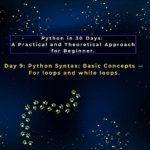Introduction
Welcome to Day 10! Now that you understand the basic for loop from yesterday’s lesson, it’s time to see its true power. One of the most common and essential tasks in programming is iterating through the items in a data structure. Today, we’ll explore how to use a for loop to seamlessly work with Python’s core data types, giving you a deep understanding of looping in Python.
The for loop’s strength lies in its ability to handle any iterable object, which includes all the primary data structures we’ve discussed. Let’s dive into how to apply looping in Python to each one.
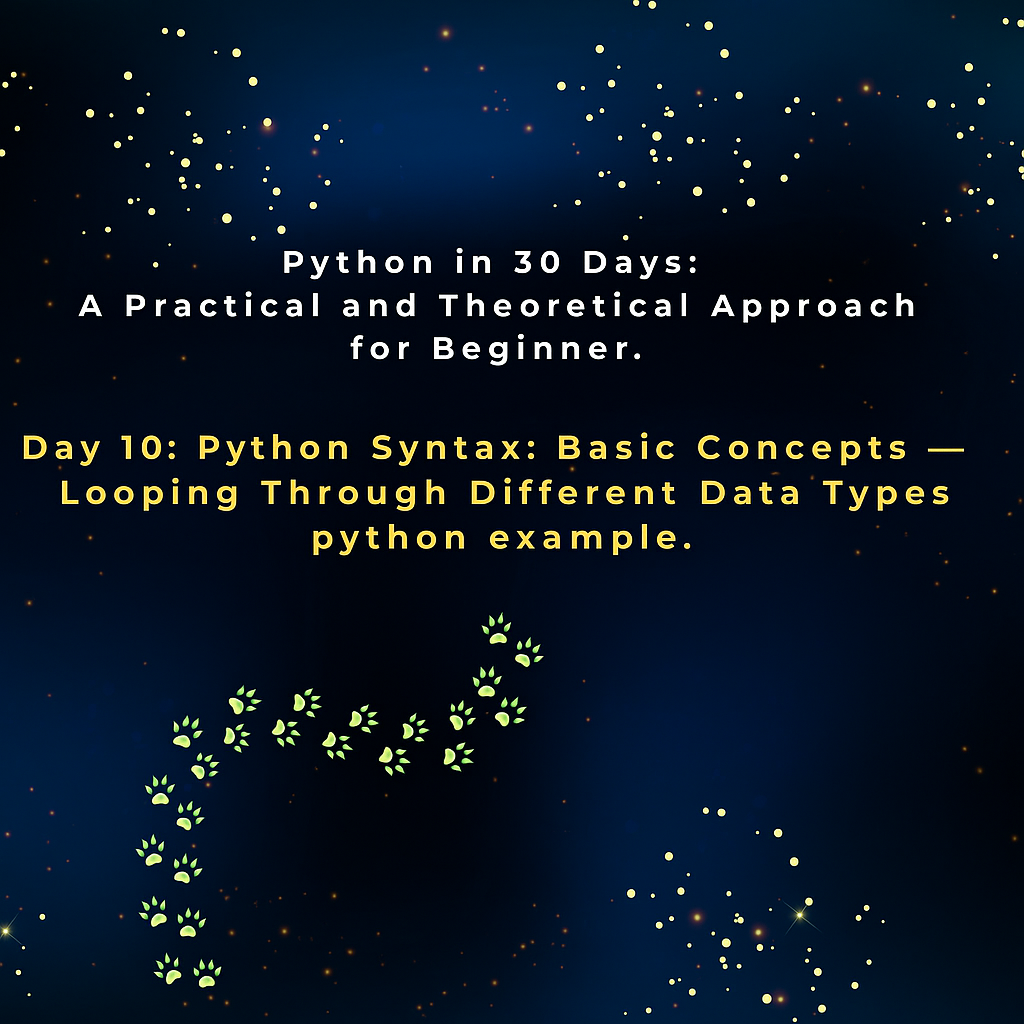
Looping Through a List
Lists are ordered collections, making them a perfect fit for a for loop. The loop will process each item in the list, from the first to the last. This is the most common and readable way to iterate through a list.
Pythonfruits = ["apple", "banana", "cherry"]
# Basic looping through a list
for fruit in fruits:
print(fruit)
# Output:
# apple
# banana
# cherry
If you need the index of each item as well, you can use the built-in enumerate() function. It returns both the index and the item for each iteration, which is incredibly useful.
Pythonfor index, fruit in enumerate(fruits):
print(f"Index {index}: {fruit}")
# Output:
# Index 0: apple
# Index 1: banana
# Index 2: cherry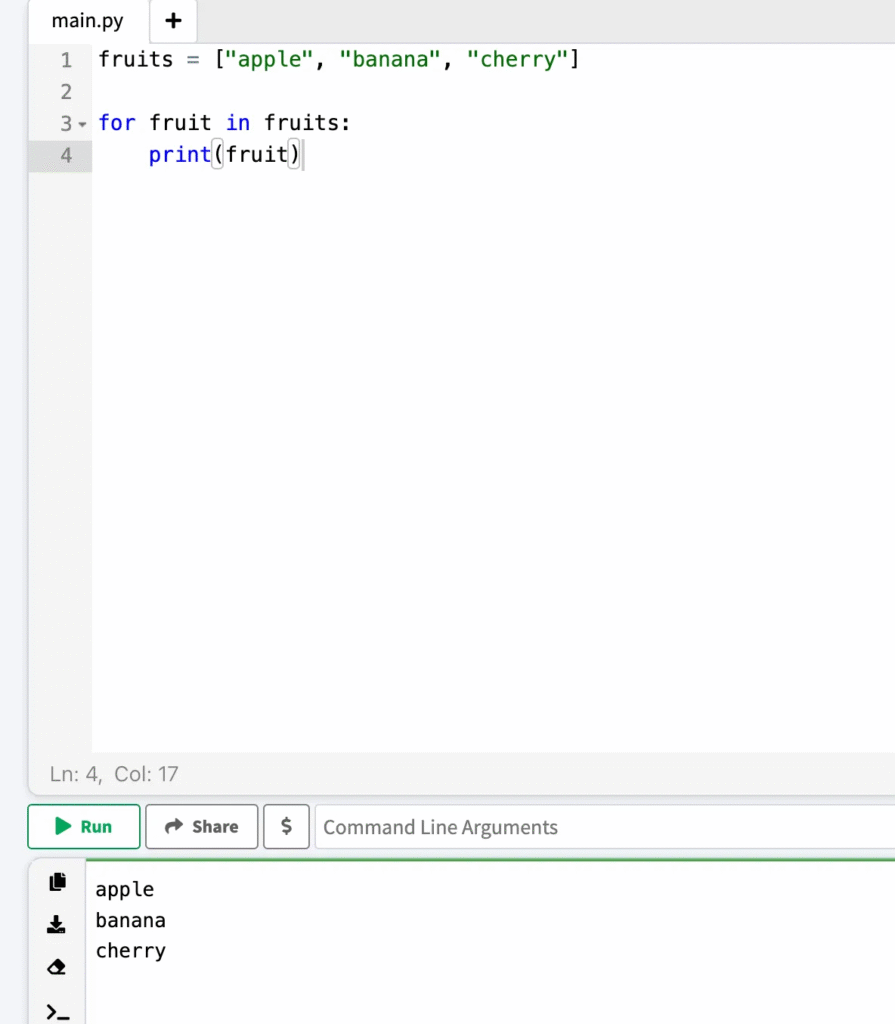
Looping Through a Tuple
A tuple is very similar to a list in that it is an ordered collection. Therefore, looping in Python through a tuple works exactly the same way.
Pythoncoordinates = (10, 20, 30)
for point in coordinates:
print(point)
# Output:
# 10
# 20
# 30
This is particularly useful when you have a list of tuples and need to unpack the values in the loop.
Pythonstudents = [("Alice", 25), ("Bob", 22), ("Charlie", 28)]
for name, age in students:
print(f"{name} is {age} years old.")
# Output:
# Alice is 25 years old.
# Bob is 22 years old.
# Charlie is 28 years old.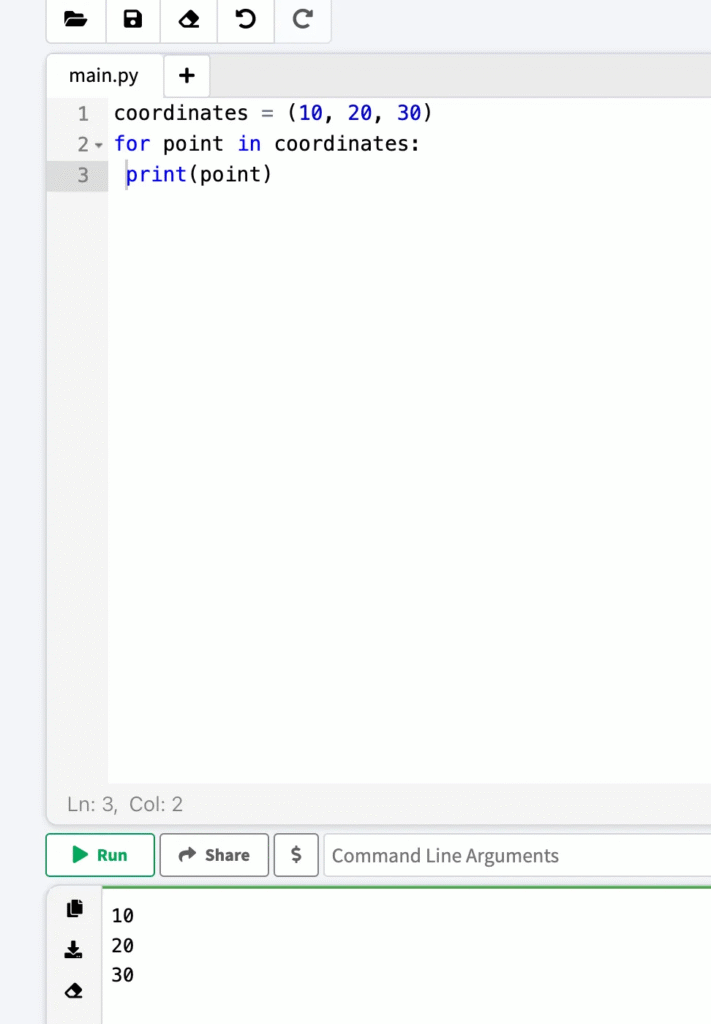
Looping Through a Dictionary
Dictionaries store data in key-value pairs, which gives you more options for looping in Python. By default, a for loop will iterate through a dictionary’s keys.
Pythonperson = {"name": "tom", "age": 30, "city": "dallas"}
# Loop through keys (the default behavior)
for key in person:
print(key)
# Output:
# name
# age
# city
To loop through the values or both the keys and values, you can use a dictionary’s built-in methods, such as dict.keys(), dict.values(), or the most common dict.items().
Python
# Loop through values using the .values() method
for value in person.values():
print(value)
# Output:
# tom
# 30
# dallas
# Loop through both key-value pairs using the .items() method
for key, value in person.items():
print(f"{key}: {value}")
# Output:
# name: tom
# age: 30
# city: dallas
Using the .items() method is often the most useful approach, as it gives you access to both parts of the dictionary entry at the same time. The Python documentation for dictionary methods is an excellent resource for learning more.
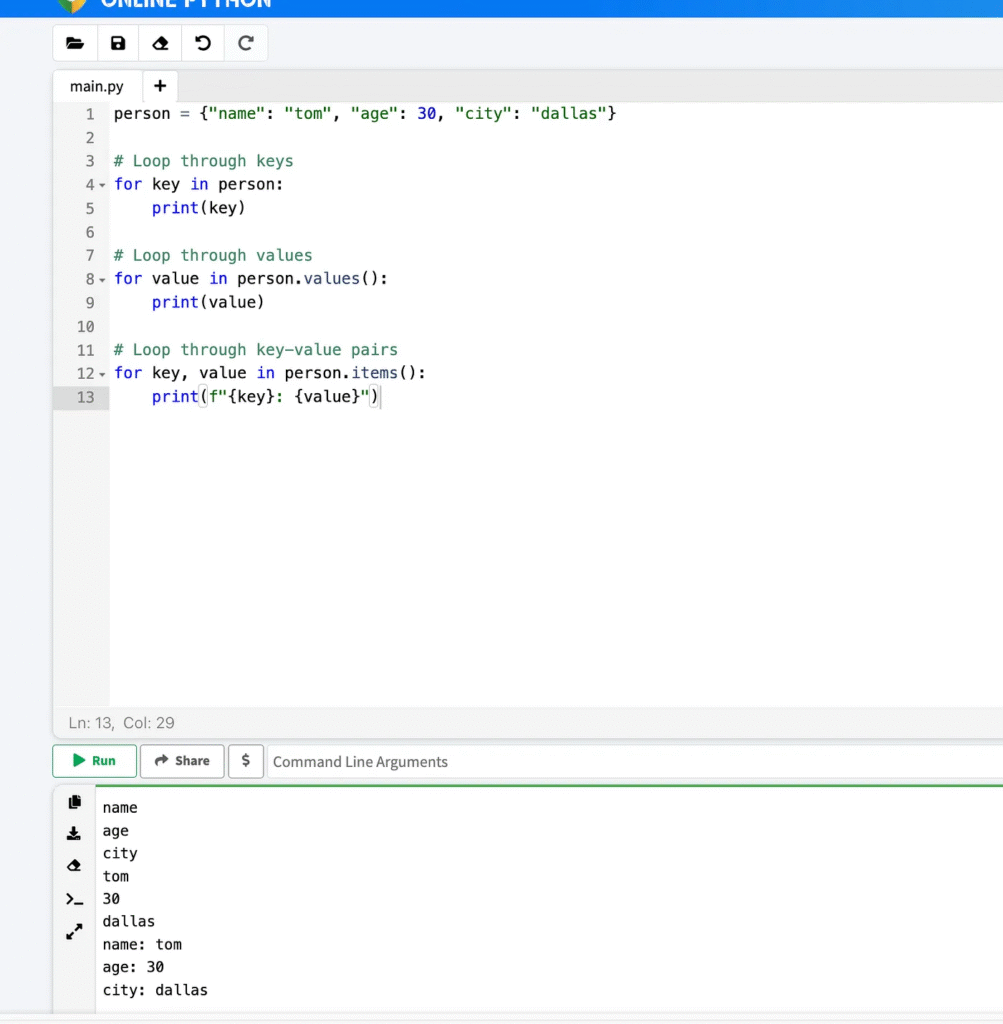
Looping Through a Set
A set is an unordered collection of unique items. When you loop through a set, the order of the items may not be the same as the order they were inserted, which is a key difference from lists and tuples.
Pythonunique_numbers = {1, 2, 3, 4}
for number in unique_numbers:
print(number)
# Output (order may vary):
# 1
# 2
# 3
# 4
For most practical purposes, the order of iteration in a set is not a concern, as sets are typically used when you only care about the presence of an item, not its position.
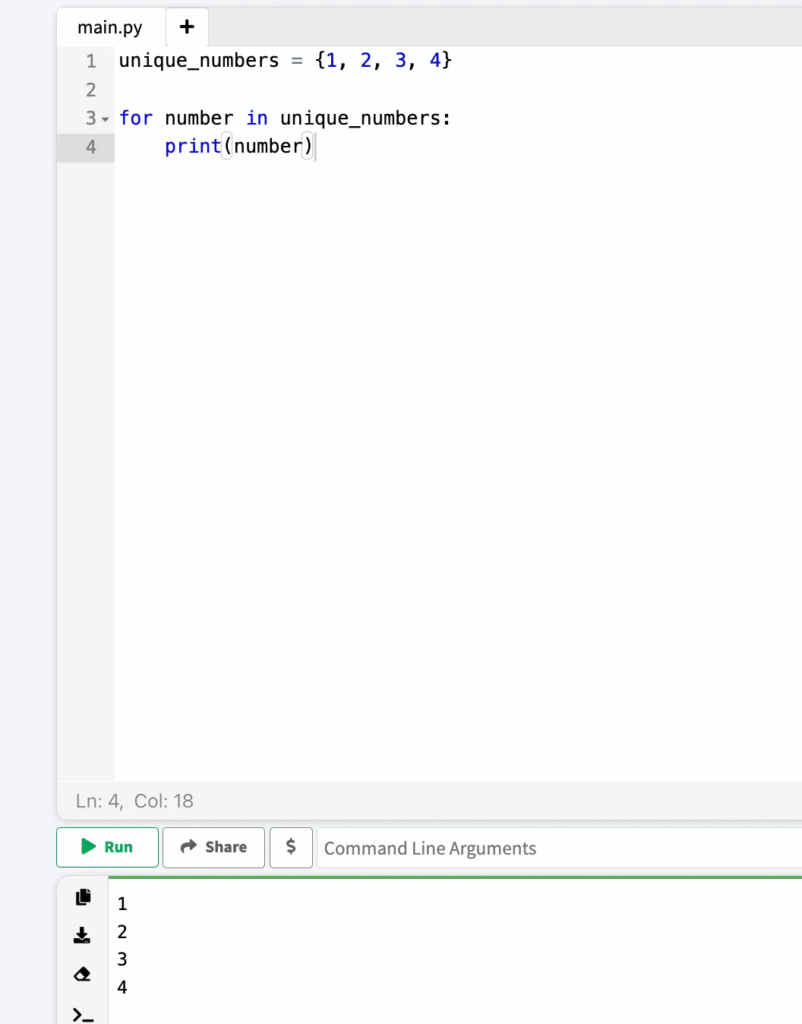
Looping Through a String
Strings are also sequences of characters, so you can easily loop through each character in a string. This is a fundamental looping in Python example for processing text.
Pythontext = “Hello” for char in text: print(char) # Output: # H # e # l # l # o
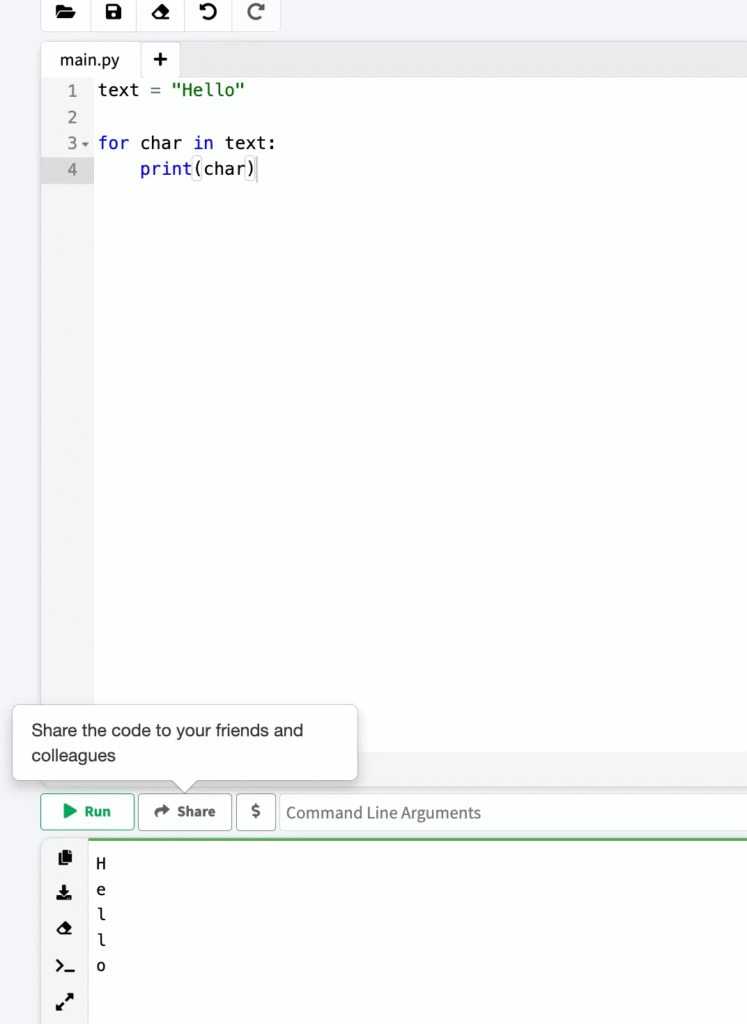
Combining Loops with Other Concepts
One of the most powerful aspects of looping in Python is combining for loops with other control flow statements.
- Conditional Statements (
if): You can useifstatements inside a loop to perform an action only when a certain condition is met. - Loop Control Statements (
break,continue): Thebreakstatement immediately exits the loop, while thecontinuestatement skips the current iteration and moves to the next one. For more, see the Python tutorial on control flow.
Pythonnumbers = [1, 5, 10, 15, 20]
for num in numbers:
if num > 10:
break # Exit the loop if the number is greater than 10
print(num)
# Output:
# 1
# 5
# 10
for num in numbers:
if num % 2 != 0:
continue # Skip odd numbers
print(num)
# Output:
# 10
# 20
Summary
Today, you learned how flexible and powerful looping in Python is by using the for loop to iterate over Python’s main data types.
- Lists and Tuples: Loop directly through them to access each item. Use
enumerate()if you need the index. - Dictionaries: Use the
.keys(),.values(), or.items()methods to access what you need. - Sets and Strings: Loop directly through them to access each element, keeping in mind that sets are unordered.
- Control Flow: Combine loops with
if,break, andcontinueto build more sophisticated logic.
This foundational knowledge is a critical step in your programming journey, as it allows you to process and manipulate any collection of data.
The journey of learning what Python is is an exciting one, and this “30 Days of Python” series is designed to be your roadmap. Happy coding!

The Best Healthy Lemonade Recipe for Hydration & Immunity
Introduction Your…
Navigating the Digital Mind: The Impact of Technology on Mental Health
Introduction Technology…
Beginner’s Guide to Home Workouts Without Equipment
Introduction Starting…
Elevate Your Health: The Ultimate Immune System Boost Guide
Introduction Your…
How AI is Transforming Healthcare: From Diagnosis to Treatment
Introduction Artificial…
Top 5 Wearable Devices to Track Your Fitness and Health
Introduction: In…







